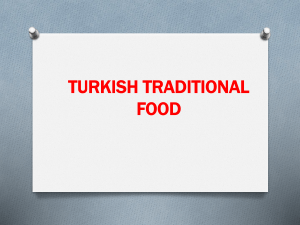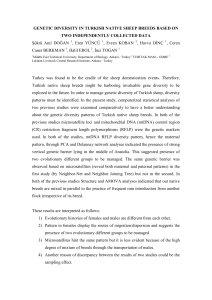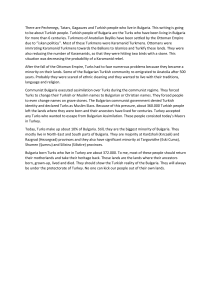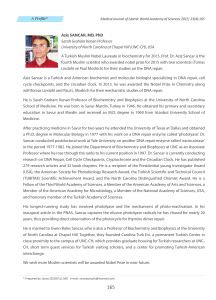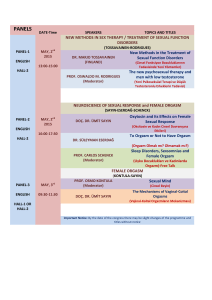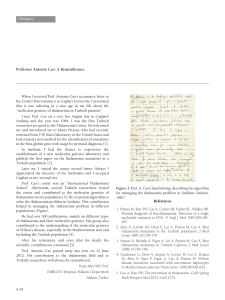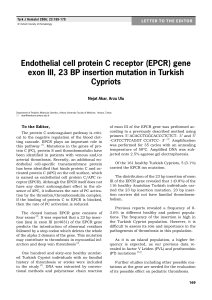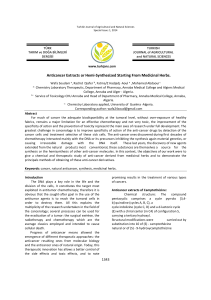Uploaded by
common.user18212
sınırları ihlal edilen doğanın intikamı - ramazan korkmaz
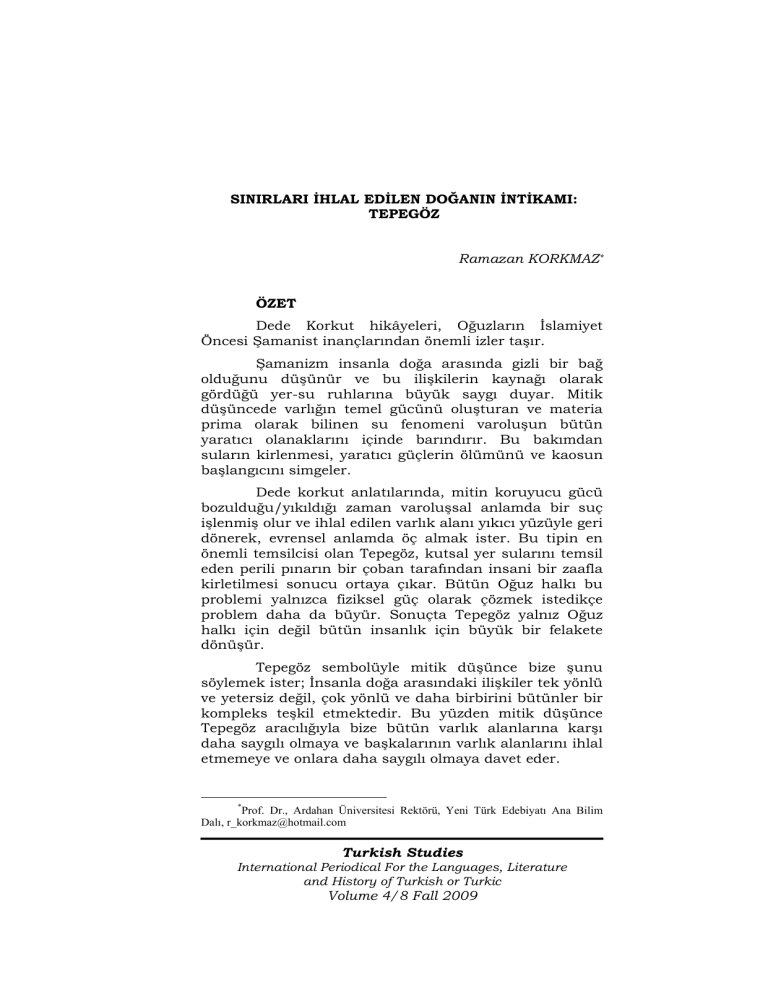
SINIRLARI İHLAL EDİLEN DOĞANIN İNTİKAMI: TEPEGÖZ Ramazan KORKMAZ* ÖZET Dede Korkut hikâyeleri, Oğuzların İslamiyet Öncesi Şamanist inançlarından önemli izler taşır. Şamanizm insanla doğa arasında gizli bir bağ olduğunu düşünür ve bu ilişkilerin kaynağı olarak gördüğü yer-su ruhlarına büyük saygı duyar. Mitik düşüncede varlığın temel gücünü oluşturan ve materia prima olarak bilinen su fenomeni varoluşun bütün yaratıcı olanaklarını içinde barındırır. Bu bakımdan suların kirlenmesi, yaratıcı güçlerin ölümünü ve kaosun başlangıcını simgeler. Dede korkut anlatılarında, mitin koruyucu gücü bozulduğu/yıkıldığı zaman varoluşsal anlamda bir suç işlenmiş olur ve ihlal edilen varlık alanı yıkıcı yüzüyle geri dönerek, evrensel anlamda öç almak ister. Bu tipin en önemli temsilcisi olan Tepegöz, kutsal yer sularını temsil eden perili pınarın bir çoban tarafından insani bir zaafla kirletilmesi sonucu ortaya çıkar. Bütün Oğuz halkı bu problemi yalnızca fiziksel güç olarak çözmek istedikçe problem daha da büyür. Sonuçta Tepegöz yalnız Oğuz halkı için değil bütün insanlık için büyük bir felakete dönüşür. Tepegöz sembolüyle mitik düşünce bize şunu söylemek ister; İnsanla doğa arasındaki ilişkiler tek yönlü ve yetersiz değil, çok yönlü ve daha birbirini bütünler bir kompleks teşkil etmektedir. Bu yüzden mitik düşünce Tepegöz aracılığıyla bize bütün varlık alanlarına karşı daha saygılı olmaya ve başkalarının varlık alanlarını ihlal etmemeye ve onlara daha saygılı olmaya davet eder. * Prof. Dr., Ardahan Üniversitesi Rektörü, Yeni Türk Edebiyatı Ana Bilim Dalı, [email protected] Turkish Studies International Periodical For the Languages, Literature and History of Turkish or Turkic Volume 4/8 Fall 2009 66 Ramazan KORKMAZ Anahtar Kelimeler: Dede Korkut Hikayeleri, Su kültü, Çevre ve insan varlığı, Varlık tabakaları, Ontolojik mesafe ilkesi. THE REVENGE OF RAPED NATURE: ONE-EYED GIANT/TEPEGOZ ABSTRACT Dede Korkut Stories, contain significant traces of the shamanic beliefs found among the Oghuz people before Islam. In Shamanism, respect is always shown to earth/ water spirits which form the foundation of constructive relations between mankind and nature. The The water phenomena known as materia-prima in mythical thought are considered to be a result of occult and universal existential powers. In this respect, the pollution of water symbolizes the death of creative values and the beginning of chaos. In Dede Korkut stories, each time going beyond the preventative aspect of myth, nature, with her destructive face and as universal threat returns and wants to take revenge. The most typical representative of this threat is Tepegöz (One-Eyed Giant), who appears as a result of the pollution of Perili Pınar caused by a shepherd's mistake feeds on human flesh. The more the Oghuz People tries to solve this situation by physical power the bigger and the more complicated the problem becomes. Then Tepegöz becomes not just a disaster only for the Oghuz people but for the whole of humanity. Myth speaking through the Tepegöz symbol, tells us that the relation between mankind and nature is not a one way and unqualified fait-accopli, but rather it invites the whole of humanity to show respect towards other layers of being. - The Book of Dede Korkut - A Turkish Epic (1991), (Translated into English and Edited by Faruk Sümer, Ahmet Edip Uysal, Warren S. Walker), University of Texas Press- Texas- USA Turkish Studies International Periodical For the Languages, Literature and History of Turkish or Turkic Volume 4/8 Fall 2009 The Revenge Of Raped Nature:... 67 Key Words: Dede Korkut Stories, Water-cult, Materia-prima, environment and human-being, layer of being, Ontological distance principle. Introduction The Tepegöz narration is based on two interrelated main points in terms of dramatic action. The first one is the drawback of the mortal man, who created the untouchable Tepegöz and the second is the achievement of the „reasoning man‟ who prevents an universally spreading calamity. When, due to his incompatibility that is impossible to hide or prevent his struggle to find a place within the sphere of existence leads to a conflict of existence with the Oğuz society, all the traditional and, yet, impractical ways to solve such a conflict are questioned in the world of fiction. Therefore, in terms of homo-semioticus our reading activity must turn into a search for meaning, by attempting to answer the questions of “what”, “how” and why” as related to this existential danger threatening the future of the Oğuz, and those impractical methods of solution. a- Existential (ontic) distance principle and provoking sin the Modern ontology regards the being as a heterogenous structure consisting of several steps. This heterogenous structure which has a pyramid-like extension consists of layers of being by Nicholai Hartmann (MengüĢoğlu 1971, 21). Altough these layers, forming a determined unity, are autonomous, they are not completely out of context. Altough each sub-step determines the upper one, it has to comply with the rule of ontic distance in between; in other words, a continous movement from one layer to another is not possible (Tunalı 1971, 32) The intrigue fiction belonging to the first episode in the Tepegöz narration starts with the violation of this categorial distance principle between the two layers of being, which cannot be interfered with in ontological terms: “One day the Oghuz people went to their summer grazing graund in the mountains. Uruz Koja had a shepherd by the name of Konur Koja Saru Choban (Yellow Shepherd). When the Oghuz people were to move to their summer pasture, he always went ahead of them. Turkish Studies International Periodical For the Languages, Literature and History of Turkish or Turkic Volume 4/8 Fall 2009 68 Ramazan KORKMAZ There was a famus watering place there called Long Fountain, which had been possessed by fairies. This time, the sheep were frightened all of a sudden. The shepherd, angry at the young lead ram that he thought was responsible, walked to the front of the flock to see what was amiss. He saw a troop of fairies, linked wing to wing and dancing about. He threw his shepherd‟s cloak upon them and caught one of them. He took this fairy to bed with him, but soon the sheep began to be frightened. When the shepherd ran to the head of the flock, the fairy flipped her wings and flew away, saying: “Shepherd, when a full year has passed, I shall have something for you. Come then and get it. But now that you have brought misfortune to the Oghuz people.” When the shepherd heard these words, he was frightened and his face grew pale.” (The Book of Dede Korkut, Translated into English and Edited by Faruk Sümer, Ahmet Edip Uysal, Warren S.Walker, Austin: University of Texas Press. 1991, p.123) As is seen, the Long Fountain/the River of Fairies (Perili Pınar) is a symbolic place where awareness is important. This makes it a “holy place”. Its charecteristic as a place, regarded as “space” connects it to the inorganic layer; and its being a “holy place” suggests the social geist layer of norms and beliefs in connection with the “soil-water souls” (Ögel 1988, 417) of the ancient Turks. The spring where the sheep drink water and lay around is the inorganic world, while the place where the nymphs fly is the geist layer, both holy and loaded with meaning and associations. According to ancient Turk belief, soil and water were defined by the word “ıduk” (holy), meaning “God‟s present”, and it was supposed that each had owners, named as their “idi”, “izi” and “iye”. In the Göktürk texts there is the “ıduk yer sub” expression. Abdulkadir Inan states that “ıduk yer sub” (holy place-water) means “protective souls” as well as “homeland”, and that today‟s concepts of mountain, water (river, lake, spring), tree, forest and rock for the Shamanist Turks were closely related to the same expression. Bahaeddin Ögel suggests that the sentence “I departed form my land and water!” in the YENĠSEY text is used to evoke the idea of “death”. As is seen, the soil and water are accepted not only as the inorganic layer of being in the social sense but also as a geist form on the level of deep associations. The making out of the action that creates the Tepegöz, is essential: The pioneer of the Oghuz, Konur Koca Saru Choban (Yellow Shepherd), has raped the fairy/nymph by violating both the sipirtual existence area of the Nymped-Fountain water), and that of the fairies merrily playing around it. That demaning and degrading Turkish Studies International Periodical For the Languages, Literature and History of Turkish or Turkic Volume 4/8 Fall 2009 The Revenge Of Raped Nature:... 69 action is a kind of crime committed in the name of the Long Fountain against “ıduk yer-sub” (holy place-water) sipirits, especially with the pollution of these water springs needed to be protected. The motif of protection of the holy values is violated, as the “tama/weakness” expression suggests in the text, and the ontic principles are completely ignored. This inner destruction in the system of existence will be seen in the form of humanistic disorder, and therefore, the myth will operate in order to protect itself. Water is one of the prior elements which includes all the possibilities of existence, and is regarded as the materia prima of the universe. As it is the source of existence it should be protected and respected. This acceptance of the myth is, in fact, a call for respect for the principle of the uniqueness of the existence layers. Yet, the human history is, in a way, mankind‟s struggle against his/her drawbacks. Throught the naration, the human aspect of the shepherd is brought to the fore. All the happenings, his curiosity and further investigation, his manly attraction and wish to have it fulfilled, his surrender to his instincts and the resultant rape all help to epitomize human nature, by carryng the actions of the charecter, who is devoid of extraordinary qualities, beyond time and place to a more universal level. Worry, practise, conscience, fear and death are concepts only related to mankind‟s historical aspect and emphasise it. Expect for humans, no other living being can create such spheres of existence. In its ontologic meaning, man possesses the germs of sin in terms of biopsyche. Commiting a sin means his own degradation by an action comitted against a value. Yet, it is a part of his existence as a historic being. When the motif of fallen souls being driven out of Heaven is considered, in fact, the crime of the Shepherd is comprehended in a deeper sense. b- Ruthless nature and the helplessness of help “Tepegöz said: “I want to eat sixty men a day!” (p. 125) One year later, the Oghuz people were migrating toward the plateau as usual. When they came to the Long Fountin they again came across the fairy girl. This time the fairy girl didin‟t try to escape. She herself approached and dropped “the mass” in her arms to Konur Koja Saru Choban and siad: “Shepherd! Come and get what I have brought for you. Butremember you have brought misfortune to the Oghuz people.” Turkish Studies International Periodical For the Languages, Literature and History of Turkish or Turkic Volume 4/8 Fall 2009 70 Ramazan KORKMAZ “When the Shepherd looked at the mass he was terrified. He stepped back and started throwing stones at it with his sling, but as he hit it, it grew larger. He than ran away, leaving the mass where it was, and his flock followed him. It happened at the time that Bayındır Khan and his beys (his masters) were making a tour. When they came to this fountain, they saw a frightening thing, a sapeless mass, lying on the ground. While they stood around it, a young man got down from his horse and kicked it. As he kicked, the mass grew still more. Several other young men came down from their horses and began kicking, and it kept growing. Even Uruz Koja came down from his horse and gave it a few kicks. When his spurs struck it, the mass was split in two, and a boy popped out from inside. Altough he has a human body, he had only a single eye, on the top his head.” (p.123-124) The text gains a new dimension by developing in a set up that depends on the questions of approaches to the crime comitted in another being‟s area and its bad results. The results of the infringement and seduction actions, presented in the first scene, come out now: The Konur Koca Saru Choban (Yellow Shepherd) dirtied the Long Fountain, that is the source of being and creation, the materia prima and the shelter of the holyness, by touching its untouchable water for himself individually (individual geist) and for the social classes (social gesit) in general. Nature returns her damaged part to the human beings in the form of the Tepegöz in order to give mankind a lesson. Thus, we can define Tepegöz as a transcendatal reality‟s becoming concrete and active in the known world in order to prove the intransitivity of the categorial distance among classes principle that is defined as “edios, the unchangeable thing among changes” in Husserl. In fact, the real problem starts after a destroyed excessiveness, that is signed in the return back affair, occurs; when Tepegöz wants to take a part in social classes; he can‟t get along in the geist layer or in the psychological layer because of his overgrow body, nor can he get along among nymphs as he can‟t fly. He cannot find a place in the world. This situation is stated in the lines: “I used to say , „let me rise up from my place And break my peace with the strong Oghuz beys, And start eating their newly born sons.” (p.132) Turkish Studies International Periodical For the Languages, Literature and History of Turkish or Turkic Volume 4/8 Fall 2009 The Revenge Of Raped Nature:... 71 Considering this, one of the cases that we should be careful about is starting to question Oghuz‟s problem-solving methods metaphorically in the text: It is seen that, Tepegöz dosen‟t open the unknown, himself with familiar methods: the strange looking “mass” given by the Nymph to the Shepherd is being closed and getting bigger as it tries to be comprehended by the known methods which include throwing stones, hitting, and kicking, the kicking of the masters. The comprehensive methods, that depend on just physical power and violence, like “throwing stones, hitting, kicking”, in order to understand the unknown, turn into an escape with the motives of fright when these methods make the problem bigger and fear occurs; “When the Oghuz people were unable to have any effect on Tepegöz, they were frightened and they tried to flee...” (p.125) However, escape isn‟t a solution; “Tepegöz cut off their escape route and would not let them go. Seven different times, the Oghuz people were frightened away form their homland, and each time they were brought back again by Tepegöz.” (p.125) They take Tepegöz to the house; he first takes the milk then the lives of the nursing women. When he has grown a little bit, he starts to eat the childrens‟ noses and ears and he plays with them in the street. Because of this he is dismissed from the nomad group and his mother sanctifies him with the principle of intransitivity belongs to her being part living in his part; as a result he becomes “uncuttable by a sword, unpierceable by a pike.” When Tepegöz wants to enter of social world the realy dangerous face of the spoilt nature/creation comes out clearly: “Tepegös said: “I want to eat sixty men a day.” (...) The people accepted this arrangement. Those having four sons gave one away and had three left. Those having three sons gave one away and two left. Those having two sons gave one away and had one left. There was a man by the name of Kapak Khan who had two sons. He had given one son away and was left now with only one. But now it was his turn to give the remaining son away. His wife cried and expressed much grief.” (p.126) Tepegöz wants sixty men everyday to eat. This offer is a kind of invoice for the people, who made him a freak of nature and made him grow up by kicking, dismissing him, hitting with swords” and arching and corrupted him, to be paid. There is no possibility of not to be paid for this invoice. Because Tepegöz has the appearance of a seduced transcendantal reality‟s individiualized state, it is Turkish Studies International Periodical For the Languages, Literature and History of Turkish or Turkic Volume 4/8 Fall 2009 72 Ramazan KORKMAZ impossible for humanity to escape from this. This Tepegöz creature becomes “uncuttable by black warrior real swords”, “unpierceable by pikes”, “untouchable by hard arches” as he has a sanctified essense. However, up to now, Oghuz had never frightened people like this, he becomes desperate and worn out: “The Oghuz people organized themselves and attacked him. When he saw them coming, he angrily uprooted a tree and threw it amid their ranks, killing fifty or sixty men. He hit Kazan, the leader of the heroes (the leader of Alps), turning the world dark to him. Kara Göne, the brother of Kazan, was overcome by Tepegöz. Alp Rüstem, the son of Düzen, was killed by Tepegöz, and so, too was the son of Ushun Koja, a brave man. Aruk Jandan and his two blood brothers also died at his hands. Mamak, wearing a suit of armor, was killed by him, and Bügdüz Emen, with the bloody moustuaches, was overcome. (...) When the the Oghuz people were unable to have any effect on Tepegöz, they were frightened and they tried to flee.” (p.125) This phenomenon that obliges Oghuz to make a certain change turns a series of novelty, from the problem solving methods to the characteristics of the men dealing with them, in to a certain obligation: There is an impact on “Kazan, the leader of Alps”, who is the main example of a type of Alp that is a solution. This charecter, Alp Rüstem, also appears as Black Güne, Kıyan Selçuk, Iron-suited Mamak, Bloody moustached Bügdüz Emen as a result this character (Alp) steps to invalidate by losing trust. At this level, as a type type Alp‟s power and knowledge of Old/Great (Ulu KiĢi) has one aim to unite and to create a more practical and deeper type. Because of this, we consider Tepegöz story as the start of an important type changing process in Turkish literature. Both as the transition period and as the charcteristics of the characters, after this rank, can be easily considered to come out with a certain necessity of a type change as synthesized. Since, trying to exist by just using power not only makes the problems more mixed and unsolvable after a certain point but also causes a loss of time, power and value as action and knowledge are gathered within different ones. However, Oghuz Khan, who starts their way with principle of “More sea, more land/ sky is our tent and sun is our flag” can‟t stand the loss of time, power and value. This obligatory changing necessity also shows how Oghuz society experienced the aprioric learning process in epistemological meaning: Time is continuously flying by and mankind always has to reach a higher level of knowledge contrary to the developments that can threaten his life and universal existence. Turkish Studies International Periodical For the Languages, Literature and History of Turkish or Turkic Volume 4/8 Fall 2009 The Revenge Of Raped Nature:... 73 c- Basat whose name is known and the solution that is in the difference of awareness “Dede Korkut came and said: „My son you are a human being. Do not associate with an animal. Come ride the beautiful horses, along with fine young men.” Lurking within the first theme, there is the tragic reality of the typical man who fights and loses at the “tama‟ ” (to weakness/ desire) point with the attraction of the sin seed he has in ride him; The process between the tragic reality‟s being lived and comprehended points to the necessity of the change, what is many-sided and with an existentialist character that belongs to the human, in a main hypogram (Riffaterre 1988, 417); “When the Oghuz people were unable to have any effect on Tepegöz, they were frightened and they tried to flee (...) Tepegöz cut off their escape route and would not let them go. Seven different times, the Oghuz people were frightened away form their homland, and each time they were brought back again by Tepegöz.” (p.125) While Tepegöz is causing unavoidable, unhinderable and uncontrollable disasters, the narrator starts to bring the second theme, that is being injected in a spiral organization within the dramatic action, forward. This theme‟s main hypogram can be defined with the sentence that human can provide relief for himself and universe‟s by understanding the differences of awareness. The utterance, that Dede Korkut made to Basat “My son you are a human being. Do not associate with an animal.” undertakes the mission of the action point for creating “I” and “conscious” (Spiegelberg 1976, 262-263) concepts that are the nucleus of Husserl‟s phenomenology. Thus, human beings, that can not construct the relation between knowledge and existence categories, find the way to return back by holding this utterance. This demand opens to sincerity by “My son” saying, consciousness of “I” by “you” word and a high value composition by “You are a human being” belief: While it is being said “My son you are a human being. Do not associate with an animal”, we especially want to take your attention to the coincidence in “Do not associate with an animal” saying. Phenomenology gives great importance to imaging the essence. Husserl assumes the phenomena‟s returning back to themselwes of the imaging of the essence, that he accepts as a value that is uncoincidental and unchangeble in objective time, as the principal of action (Husserl 1970, 252). Turkish Studies International Periodical For the Languages, Literature and History of Turkish or Turkic Volume 4/8 Fall 2009 74 Ramazan KORKMAZ Dede Korkut sees Basat‟s “Do not associate with an animal”, concidentally, while he is addressing to him who has been brought up by lions after he was dropped as the Oghuz peple were running away frightened, and he wants him to turn back to his essence, that is unchanged despite the gone away objective time, by being saved from this: “My son you are a human being. Do not associate with an animal” Humanity‟s state not only indicates the essence of Basat that dosen‟t change in time, but also stresses his belonging to a spesific social class. This utterance also makes mankind reach to the conscioussness of himself in the universe‟s most developed and perfect place by stressing the principle of the intransitivity among the social classes certainly. With this side, man is the only creature that exists with the consicoussness of the relation between himself and things. This conscioussnes of being in relation makes him Da-sein, with Heidegger‟s claim, among other creatures. A da-sein a human being is a person who comprehends the relations, that he has with himself and other things, derivative abundance and variety and who is aware of his opportunities and vacancy. This human has a rigging that can set up himself again any time and is open to anxiety. This rigging holds him in a continuous existance. When Basat turns the power, the present of the nature, into “directing towards something” and “being about something” with the light of the saying “You are a human being”, he becomes a Da-sein man. That is, he is saved from dissappearing among things by comprehending and indicating his place among social classes, and he returns to his essense and lives his awareness. The solution comes out with this conscioussness turning into a continuous inner enlightenment. Basat uses pre-known methods against the disaster created by Tepegöz; he throws stones, hits with the sword, throws arches etc. However, when he sees that these actions aren‟t enough to solve the problem, contrary to others escaping from or denying him, he produces new questions in his mind and tries to create solution compositions as answers by uniting these questions with action; “Basat said to them: “Beys, (...) What do you think about this?” (p.128) “Basat said “O cooks, how can one kill this creature? (...) Basat go near Tepegöz‟s head, lifted his eyelid, and saw that his eye was really made flesh. He than said, “Ho, cooks put the skewer in the fire and make it red hot.” (...) Basat killed this ram at once and skinned it, keeping its tail and head intact. He got into the skin and went near Tepegöz... (...) Basat saw taht a naked sword kept moving Turkish Studies International Periodical For the Languages, Literature and History of Turkish or Turkic Volume 4/8 Fall 2009 The Revenge Of Raped Nature:... 75 up and down there. He thought, “I should not grasp this sword right away.” He drew his own sword and held it against the sword mowing up and down. It saved his own sword in two. Then he took his bow in his hand and shot an arrow at the chain by which the sword was hanging. The sword fell to the ground and stuck into the earth.” (p. 129,130) As it seen, Basat not only uses the solutions available to the over come the problems, but also creates new solutions using his inititative and tries them. He never thinks about inability to solve the problems or escape. He, as a human, -for his time- is a Da-sein character who is aware of himself and his opportunites, and directs towards something, being about something by uniting the knowledge and power actions among different categories. Therefore, Basat composes an example Alp-wise type that is not talked about much in Turkish literature. This type is a deep and main charectirezed transition type that unites the knowledge of old great people, Shaman and Kam with the power of Alp and transfers the knowledge to “eren/ dervish/saint” under the effects of the acceptance of Islam. We should especially point out that this charecter has reached today through a line that doesn‟t transfer the knowledge to “eren/ dervish” through history. In fact, this Alp-wise character, that has been neglected for years, needs to be explained and discussed scientifically. Basat is that kind of an Alp-wise type that creates solution compositions by uniting knowing and acting, practises them continually and whose face totally turns to the world. However, it is observed that sometimes he acts unlike his this side. This is because of the attachment of an Islamic anxiety to the text. This state composes the only narration mistake that the principle of the reasoning is neglected and infringed in the Tepegöz story. It is especially clear that the pattern utterances and actions, that shows this type of sense in the text, aren‟t in a complete harmony with the entireness of the text and the background of the charecters and also break down the causality of dramatic action. For example, Basat escapes from death with a miracle when he is in the Künbet (water store) to get the treasure of Tepegöz; “Basat said: There is no God other than Allah, and Mohammed is His prophet. All of a sudden the walls of the terasure house were split apart and seven door appeared in seven different parts of it. Basat went out through one of these. Tepegöz pushed his hand into the treasure house and ran fast, pulling the building down. He than asked, “Young man, did you get away?” Basad said, “My Allah saved me.” (p.130) Turkish Studies International Periodical For the Languages, Literature and History of Turkish or Turkic Volume 4/8 Fall 2009 76 Ramazan KORKMAZ These statements‟ removal will cause almost no change in the story‟s structural and contextual meanings. In addition, I belive these statements were added to the text later in order to avoid criticism from Islam. This not only helped Basat in the process of humanizing, turning more to the world and developing himself but also sometimes put him in conflict with this process. However, in the life of the Basat, the main charecter of the story, there is almost no place for coincidence after Dede Korkut‟s showing him away to return. This state provides him with a solution when other solutions have come to an end. A crying mother, who has already given one of her sons to Tepegöz and now is crying for help to Basat to enable her not to give her second and last son, says: “You whom fame both Outer Oghuz and Inner know-/ Basat Khan, the son of Uruz, help me!” (p.126) She takes shelter in his being a “known” solution. “Known” statement shows Basat‟s progress in creating his essence and developing since Dede Korkut‟s warning of “You are a human being!” certainly. Because Dede Korkut gives Basat‟s name but the mission to make it “known” belongs to Basat, and he succeeds in this by developing his own esence. In fact, this crying mother symbolizes the face of life that goes on besides everything. Motherhood is a hot symbol that associates the source of all feminine, prolific and abundance. Therefore, generally the face of life going on expects and requires responsibilites and sacrifices, that the crying mother wants from “known” Basat specially for her son, from all the Da-sein caharecters. If not, as an Azerbaijani mother, she sings her hopes in a folk song: “I‟m a mother, I have the pain of sky and earth in my voice/ Come to peace human beings, otherwise the world will be detroyed!” Motherhood represents our humanity‟s common sense that is conciousness of the universe, the determination to live and the hope for the future. After “the known” Basat comprehends his humanitiy by quitting from “Don‟t associate with an animal ” and “Come ride the beautiful horses, along with fine young men”, he hears the voice saying “It should be!” coming from composition of values and puts all his existence after hearing this. Thus, he turns his power and knowledge into “being about something” and “turning towards something” and saves humanity from a great disaster. He deactivates the Tepegöz problem and shows an aim to be universal, by the certain and sharp changing power of fire –he burns his eyes with fire- and than he destroys him totally by cutting his head off –he breaks the sorcery with blood. This state makes Basat‟s existence more certain; his name gets more well known. Turkish Studies International Periodical For the Languages, Literature and History of Turkish or Turkic Volume 4/8 Fall 2009 The Revenge Of Raped Nature:... 77 Results We can compose the hypogram composition in Tepegöz story like this: a- As the infringement and seduction actions, existential sourced, like the inability to pass over the principle of categoric distance, aren‟t returnable, they can cause great disasters that threaten universal order like Tepegöz. b- Tepegöz(Cyclopes) is the symbol of the ugly hidden in the beautiful, death hidden in life, and chaos hidden in cosmos. Each being carries the processes of their own destruction within itself. Crimes and intrusions done against any area of existence ensure the emission of the negative power of destruction, and its dispersion. c- Crimes against the nature and humanity take the humankind backwards with their cyclical destructive effects. The consequences of these crimes, like Tepegöz(Cyclopes), aim at the whole humanity regardless of the guilty and the innocent. In the recent times, parallel to the development of science and technology, intrusions of the existence areas have been increasing; pollution of air and water, nuclear leakage, chemical waste, the damage done by wars on human psychology and the rhythm of nature; these are all preparations for the birth of new Tepegoz(cyclopes). d- When mankind loses the battle against his inner weakness the “tama/h‟ (desire)” point, and infiringes like this, he shouldn‟t show the same indifference. Also after the problem comes out, he should never try to solve the existantial problems by the use of violence, like pushing, kicking, cutting and throwing stones. e- In such a difficult state, human, that is the conscious of the universe, first has to comprehend his own awareness and then compose and practise a solution composition that can always be changeable by uniting knowledge and action. f- The relations between mankind and the universe, in fact the relations among all existing classes, aren‟t the mass of common, meaningless done issues that are caused by coincidence, but they are the meaningful and balanced influential existence process, that depends on mutal determination. g- The human is the name of a superior conscious that can get the responsibility of all mutual influential process that belongs to himself and the universe. The progress in the optimistic direction of life means the universe depends on this superior consciousness being Turkish Studies International Periodical For the Languages, Literature and History of Turkish or Turkic Volume 4/8 Fall 2009 78 Ramazan KORKMAZ directed towards the constructive and creative activity, guided by his knowledge of himself. h- The world doesn‟t belong to the powerful and the ones who live on it today; it equally belongs to those who are weak, silent, those who are far enough to not be able to make their voices heard, and it also belongs to those who will live here in the future. The world is the consciousness of the universe. The world is the home of humanity and life. We should save it from the crimes that those shepherds with low levels of perception commit. ı- We should all together prevent the processes that would breed new Tepegöz(Cyclopes). Our world is not an arena where hegemonic craziness can be tested; it is the habitat of humans and other living things. To save our world, first and foremost, we should listen the voice of mothers, as the symbol of prolificacy and life. REFERENCES HUSSERL Edmund, Logical Investigations, (Translation: J.N. Findlay), London 1970, Volume I, p. 252 MENGÜġOĞLU Takiyettin, Fenomenoloji ve Nicholai Hartmann, Ġstanbul Üniversitesi Yayınları, Ġstanbul 1976, s.21 ÖGEL Bahaeddin, Türk Kültürünün Gelişme Çağları, Türk Dünyası AraĢtırmaları Vakfı Yayınları, Ġstanbul 1988, s.417 RIFFATERRE Michael, Semiotics of Poetry, Indiana University Press, Bloomington 1984, p. 23 SPIEGELBERG Herbert, “Husserl’s Phenomenology and Sartre’s Existentialism”, Phenomenology, (Edited by Joseph J. Kockelmans, The Anchor Books Edition, New York 1976, p.262-263; The Book of Dede Korkut, Translated into English and Edited by Faruk Sümer, Ahmet Edip Uysal, Warren S.Walker, University of Texas Press Austin, 1991, p.122-133 TUNALI Ġsmail, Sanat Ontolojisi, Ġstanbul Üniversitesi Yayınları, Ġstanbul 1971, s. 32 Turkish Studies International Periodical For the Languages, Literature and History of Turkish or Turkic Volume 4/8 Fall 2009
